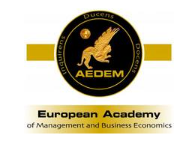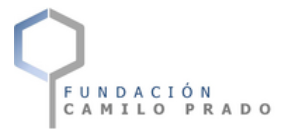Does the perceived utility of rubrics boost speaker confidence? A study in business organization courses
DOI:
https://doi.org/10.35564/jmbe.2025.0015Keywords:
self-assessment, confidence, oral communication, university, rubricAbstract
In a real academic context, taking the classroom as a reference, this research analyzes the utility that students on two university degree programs give to a rubric for preparing oral presentations. It also assesses the effect that the rubric utility has on the relationship between confidence as a speaker and self-assessment of oral presentation competence. This research was carried out with a sample of 202 university students of Business Organization subjects from two university degrees: Labour Relations and Human Resource Management and Civil Engineering. In both cases, students were required to give an oral presentation on a topic selected by the teacher. One month before presenting in the classroom, students were asked to complete a questionnaire and were provided with a rubric. Finally, after the oral presentation, each student rated his/her overall performance. To analyse data, component analysis with varimax rotation, correlation analysis and hierarchical regression analysis were applied. The results show the greater the perceived utility of the rubric, the greater the influence of confidence as a speaker on self-assessment of oral presentation performance. The rubric is useful in guiding the preparation of the oral presentation, although it seems that the perception of utility is greater for female students than for male students. From a theoretical perspective, the findings suggest that when students perceive the rubric as a credible and reliable guiding tool, a greater correspondence is observed between their perceived abilities and the grades they assign to themselves. From a practical standpoint, providing opportunities for discussion between students and teachers regarding rubric standards can enhance oral communication skills.
Downloads
References
Andrade, H. (2019). A Critical Review of Research on Student Self-Assessment. Frontiers in Education, 4(August), 1–13. https://doi.org/10.3389/feduc.2019.00087
Andrews, C. D., Richardson, M. J., & Whiting, E. F. (2025). Teachers’ definitions, beliefs, and reasons for using or not using student self-assessment. Teacher Development, 29(1), 70–90. https://doi.org/10.1080/13664530.2024.2373160
Aryadoust, V. (2015). Self- and Peer Assessments of Oral Presentations by First-Year University Students. Educational Assessment, 20(3), 199–225. https://doi.org/10.1080/10627197.2015.1061989
Bolívar-Cruz, A., & Verano-Tacoronte, D. (2018). Self-assessment of the oral presentation competence: Effects of gender and student’s performance. Studies in Educational Evaluation, 59, 94-101. https://doi.org/10.1016/j.stueduc.2018.04.001
Boud, D., & Falchikov, N. (1989). Quantitative studies of student self assessment in higher education: a critical analysis of findings. Higher Education, 18(5), 529–549.
Cardon, P., Fleischmann, C., Logemann, M., Heidewald, J., Aritz, J., & Swartz, S. (2024). Competencies Needed by Business Professionals in the AI Age: Character and Communication Lead the Way. Business and Professional Communication Quarterly, 87(2): 223-246. https://doi:10.1177/23294906231208166
De Grez, L., Valcke, M., & Roozen, I. (2009). The impact of an innovative instructional intervention on the acquisition of oral presentation skills in higher education. Computers & Education, 53(1), 112–120. https://doi.org/10.1016/j.compedu.2009.01.005
De Grez, L., Valcke, M., & Roozen, I. (2012). How effective are self- and peer assessment of oral presentation skills compared with teachers’ assessments? Active Learning in Higher Education, 13(2), 129–142. https://doi.org/10.1177/1469787412441284
De Paola, M., Lombardo, R., Pupo, V., & Scoppa, V. (2021). Do women shy away from public speaking? A Field Experiment. Labour Economics, 70:102001. https://doi.org/10.1016/j.labeco.2021.102001
Falchikov, N. (2005). Improving Assessment through Student Involvement: Practical Solutions for Aiding Learning in Higher and Further Education. Routledge Falmer.
Gaffney, A. L. H., & Kercsmar, S. E. (2016). Students’ affective learning in a technologically mediated writing and speaking course: A situated learning perspective. Journal of Business and Technical Communication, 30(3), 322–351. https://doi.org/10.1177/1050651916636371
Galván-Sánchez, I., Verano-Tacoronte, D., González-Betancor, S. M., Fernández-Monroy, M., & Bolívar-Cruz, A. (2017). Assessing oral presentation skills in Electrical Engineering: Developing a valid and reliable rubric. International Journal of Electrical Engineering Education, 54(1), 17-34. https://doi.org/10.1177/0020720916659501
Gelman, A., & Hill, J. (2006). Data Analysis Using Regression and Multilevel/Hierarchical Models. In Data Analysis Using Regression and Multilevel/Hierarchical Models. Cambridge University Press. https://doi.org/10.1017/CBO9780511790942
González-Betancor, S. M., Bolívar-Cruz, A., & Verano-Tacoronte, D. (2019). Self-assessment accuracy in higher education: The influence of gender and performance of university students. Active Learning in Higher Education, 20(2), 101-114. https://doi.org/10.1177/1469787417735604
Grieve, R., Woodley, J., Hunt, S. E., & McKay, A. (2021). Student fears of oral presentations and public speaking in higher education: a qualitative survey. Journal of Further and Higher Education, 45(9), 1281–1293. https://doi.org/10.1080/0309877X.2021.1948509
Jonsson, A. (2014). Rubrics as a way of providing transparency in assessment. Assessment and Evaluation in Higher Education, 39(7), 840–852. https://doi.org/10.1080/02602938.2013.875117
Jonsson, A., Panadero, E., Pinedo, L., & Fernández-Castilla, B. (2025). Using rubrics for formative purposes: identifying factors that may affect the success of rubric implementations. Assessment in Education: Principles, Policy & Practice, 1–20. https://doi.org/10.1080/0969594X.2025.2486947
Karaman, P. (2024). Effects of using rubrics in self-assessment with instructor feedback on pre-service teachers’ academic performance, self-regulated learning and perceptions of self-assessment. European Journal of Psychology of Education, 0(0). https://doi.org/10.1007/s10212-024-00867-w
Klenowski, V. (1995). Student Self-evaluation Processes in Student-centred Teaching and Learning Contexts of Australia and England. Assessment in Education: Principles, Policy & Practice, 2(2), 145–163. https://doi.org/10.1080/0969594950020203
Köppe, C., Verhoeff, R. P., & van Joolingen, W. (2024). Elements for understanding and fostering self-assessment of learning artifacts in higher education. Frontiers in Education, 9. https://doi.org/10.3389/feduc.2024.1213108
Krebs, R., Rothstein, B., & Roelle, J. (2022). Rubrics enhance accuracy and reduce cognitive load in self-assessment. Metacognition and Learning, 17(2), 627–650. https://doi.org/10.1007/s11409-022-09302-1
León, S. P., Panadero, E., and García-Martínez, I. (2023). How Accurate Are Our Students? A Meta-analytic Systematic Review on Self-assessment Scoring Accuracy. Educational Psychology Review, 35(4): 106. https://doi.org/10.1007/s10648-023-09819-0
Méndez, F. X., Inglés, C. J., & Hidalgo, M. D. (2004). La versión española abreviada del «cuestionario de confianza para hablar en público» (Personal Report of Confidence as Speaker): Fiabilidad y validez en población adolescente. Psicologia Conductual, 12(1), 25–42.
Miller, T. M., & Geraci, L. (2011). Training metacognition in the classroom: the influence of incentives and feedback on exam predictions. Metacognition and Learning, 6(3), 303–314. https://doi.org/10.1007/s11409-011-9083-7
Nadolski, R. J., Hummel, H. G. K., Rusman, E., & Ackermans, K. (2021). Rubric formats for the formative assessment of oral presentation skills acquisition in secondary education. Educational Technology Research and Development, 69(5), 2663–2682. https://doi.org/10.1007/s11423-021-10030-7
Nash, G., Crimmins, G., & Oprescu, F. (2016). If first-year students are afraid of public speaking assessments what can teachers do to alleviate such anxiety? Assessment and Evaluation in Higher Education, 41(4), 586–600. https://doi.org/10.1080/02602938.2015.1032212
Nieminen, J. H. (2022). Disrupting the power relations of grading in higher education through summative self-assessment. Teaching in Higher Education, 27(7), 892–907. https://doi.org/10.1080/13562517.2020.1753687
Nieminen, J. H., & Boud, D. (2025). Placing authenticity at the heart of student self-assessment: an integrative review. Teaching in Higher Education, 30(3), 640–662. https://doi.org/10.1080/13562517.2024.2367669
Nieminen, J. H., & Tuohilampi, L. (2020). ‘Finally studying for myself’ – examining student agency in summative and formative self-assessment models. Assessment & Evaluation in Higher Education, 45(7), 1031–1045. https://doi.org/10.1080/02602938.2020.1720595
Panadero, E., & Jonsson, A. (2013). The use of scoring rubrics for formative assessment purposes revisited: A review. Educational Research Review, 9, 129–144. https://doi.org/10.1016/j.edurev.2013.01.002
Panadero, E., & Jonsson, A. (2020). A critical review of the arguments against the use of rubrics. Educational Research Review, 30(August 2019), 100329. https://doi.org/10.1016/j.edurev.2020.100329
Panadero, E., Jonsson, A., & Botella, J. (2017). Effects of self-assessment on self-regulated learning and self-efficacy: Four meta-analyses. Educational Research Review, 22, 74–98. https://doi.org/10.1016/j.edurev.2017.08.004
Panadero, E., & Romero, M. (2014). To rubric or not to rubric? The effects of self-assessment on self-regulation, performance and self-efficacy. Assessment in Education: Principles, Policy and Practice, 21(2), 133–148. https://doi.org/10.1080/0969594X.2013.877872
Pekrun, R., Elliot, A. J., & Maier, M. A. (2009). Achievement goals and achievement emotions: Testing a model of their joint relations with academic performance. Journal of Educational Psychology, 101(1), 115–135. https://doi.org/10.1037/a0013383
Quinn, S., & Goody, A. (2019). An Evaluation of a Course Aimed at Reducing Public Speaking Anxiety among University Students. International Journal of Teaching and Learning in Higher Education, 31(3).
Ritchie, S. M. (2016). Self-assessment of video-recorded presentations: Does it improve skills? Active Learning in Higher Education, 17(3), 207–221. https://doi.org/10.1177/1469787416654807
Scoles, J., Huxham, M., & McArthur, J. (2014). Mixed-Methods Research in Education: Exploring Students’ Response to a Focused Feedback Initiative (Issue January). https://doi.org/10.4135/978144627305013514690
Smith, A., Schieber, D., & Austin, T. (2022). Describing Confidence: Student-Identified Signals of Presenter Confidence. International Journal of Teaching and Learning in Higher Education 2022, 33(3), 319–327. http://www.isetl.org/ijtlhe/
Smith, C. M., & Sodano, T. M. (2011). Integrating lecture capture as a teaching strategy to improve student presentation skills through self-assessment. Active Learning in Higher Education, 12(3), 151–162. https://doi.org/10.1177/1469787411415082
Taras, M. (2016). Situating power potentials and dynamics of learners and tutors within self-assessment models. Journal of Further and Higher Education, 40(6), 846–863. https://doi.org/10.1080/0309877X.2014.1000283
Tsang, A. (2018). Positive effects of a programme on oral presentation skills: high- and low-proficient learners’ self-evaluations and perspectives. Assessment and Evaluation in Higher Education, 43(5), 760–771. https://doi.org/10.1080/02602938.2017.1407917
Tsang, A. (2020). The relationship between tertiary-level students’ self-perceived presentation delivery and public speaking anxiety: A mixed-methods study. Assessment & Evaluation in Higher Education, 45(7), 1060–1072. ttps://doi.org/10.1080/02602938.2020.1718601
Van Ginkel, S., Gulikers, J., Biemans, H., & Mulder, M. (2017). The impact of the feedback source on developing oral presentation competence. Studies in Higher Education, 42(9), 1671–1685. https://doi.org/10.1080/03075079.2015.1117064
Van Ginkel, S., Gulikers, J., Biemans, H., & Mulder, M. (2015). Towards a set of design principles for developing oral presentation competence: A synthesis of research in higher education. Educational Research Review, 14, 62–80. https://doi.org/10.1016/j.edurev.2015.02.002
Violanti, M. T., & Kelly, S. (2023). Self-Assessments: Creating validated teaching and training tools. Business and Professional Communication Quarterly. https://doi.org/10.1177/23294906231203369
Yan, Z., & Carless, D. (2022). Self-assessment is about more than self: the enabling role of feedback literacy. Assessment & Evaluation in Higher Education, 47(7), 1116–28. https://doi.org/10.1080/02602938.2021.2001431

Downloads
Published
How to Cite
Issue
Section
License
Copyright (c) 2025 Journal of Management and Business Education

This work is licensed under a Creative Commons Attribution-NonCommercial-ShareAlike 4.0 International License.
License terms at: https://creativecommons.org/licenses/by-nc/4.0/legalcode



